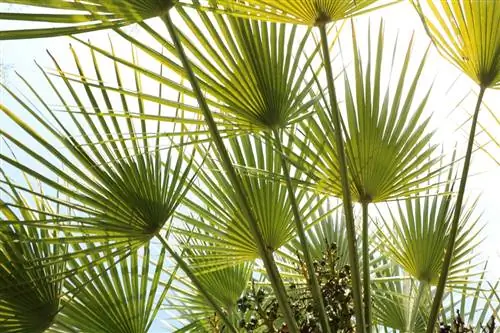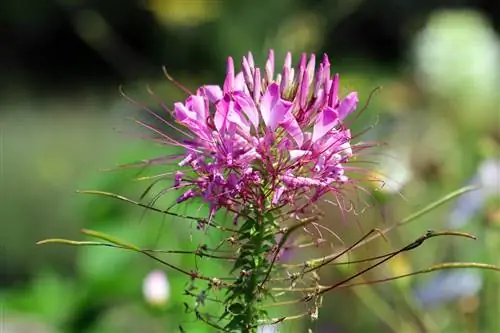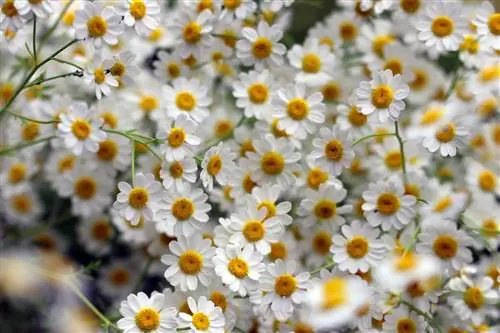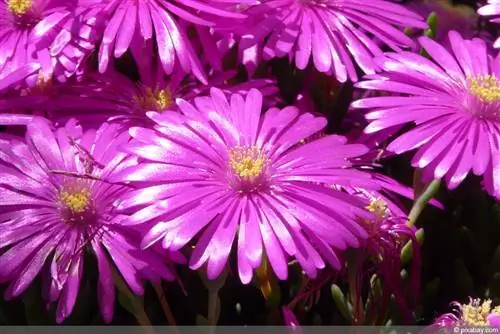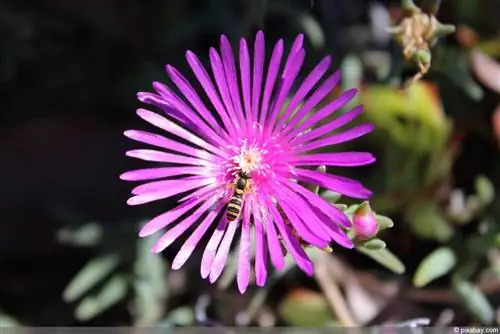- Author admin [email protected].
- Public 2023-12-17 03:39.
- Last modified 2025-01-24 12:45.
The ice begonia, also called God's eye, is a summer bloomer that is used in many different ways for planting. The plants require little care when it comes to care, but benefit from nutrient-rich soil.
Location
The location for the begonia should be sunny or partially shaded at most. The flowering plants cannot develop well in the shade, which also applies to the blazing sun and in both cases it is the leaves in particular that suffer. In the blazing sun, the plants require much more care and need to be watered more frequently.
Windy locations have little effect on begonias, but such locations are often more at risk of frost, which means the plants die earlier. This is where the name of the ice begonias comes from, as they freeze immediately at temperatures below zero, which is clearly visible in the damaged leaves.
Substrate
The begonias have no special demands on the soil and normal garden soil is sufficient for them. It is important that the soil is humus and permeable. The latter is particularly a problem when planting in containers. Although the God's Eye also blooms in bad weather, it cannot tolerate waterlogging and the roots begin to rot.
When planting in a pot or balcony box, the bottom layer should always provide drainage. Expanded clay or lava granules, for example, are suitable as drainage.
Note:
Heavily compacted outdoor soils can be loosened by mixing in sand and fine gravel. Coarse organic material such as annual compost also helps loosen the soil and continually provides nutrients through rotting.
Sowing
The begonias should be sown from January. The seeds should be in the ground by March at the latest. Otherwise, the plants may barely bloom and freeze beforehand if you don't overwinter them. Germination can take up to 14 days at a temperature of around 24°C. Ice begonias germinate in light and must not be covered with soil.
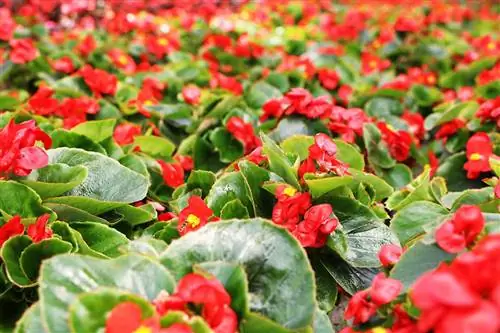
When sowing you should pay attention to the following points:
- Use lean seed soil for germination
- Use an indoor greenhouse to reduce the risk of drying out
- Press seeds carefully
- Use only a spray bottle for watering
- Place the indoor greenhouse in a bright location
As soon as the young plants are strong enough, they can be pricked out. To do this, carefully lift the young plants out of the ground with a stick or fork. As a subsequent substrate, you can use a mixture of half potting soil and half growing soil. The first substrate when pricking out should not be too nutrient-rich, as this reduces root formation. Until planting in May, the young plants only need to be watered moderately, which also promotes root formation.
Planting
From mid-May, after the Ice Saints, you can plant the ice begonia outdoors. Before that, the risk of late frosts causing lasting damage to the plants is too great. Before the young plants are permanently placed outdoors, you should get them used to it about two weeks in advance, otherwise the leaves could be damaged by the sun.
In the first week, place the God's Eyes outdoors in a protected place that receives a maximum of one to two hours of sun. From the second week you can put them in the sun for several hours, but you should still protect them a little during lunchtime.
The planting time outdoors is only limited by frost. You can still plant ice begonias in August, but they will die outdoors with the first frost.
Pouring
The ice begonia has very thick and fleshy leaves in which it can also store some water. Although the plants like a constantly slightly moist location, they also forgive it if the substrate dries out for a long time. Therefore, they are also ideal plants for graves where daily watering is not possible.
What ice begonias cannot tolerate is waterlogging. Therefore, always water regularly but only moderately. When growing in a pot, you should only fill up the saucer to the maximum. Whatever cannot be absorbed into the substrate within an hour, empty it out again.
The God's Eye prefers tempered water when watering. It is sufficient if you leave the watering can filled with water next to the plants for half a day. This means they have the ideal temperature adapted to the location. Water preferably in the morning, when the plants benefit most from watering. The ice begonia is lime-tolerant, but like many other flowering plants, prefers neutral rainwater.
Note:
When watering, make sure that you water at the ground if possible and that the leaves do not get wet. Single drops can act like a magnifying glass and damage the leaves.
Fertilize
Before planting, you can incorporate organic fertilizer such as compost into the soil. During the flowering period, the ice begonias benefit from an organic fertilizer. You should avoid using mineral fertilizers on your plants. If the ice begonia is in full bloom, it is best to use a liquid fertilizer for flowering plants. This promotes long flowering and also the formation of new buds.

pruning
If it rains persistently, the flowering of ice begonias is short-lived and varieties that have white flowers in particular look unsightly. You can remove dead flowers as you go, but it is not a must. The dead flowers and leaves eventually fall to the ground and rot. You should remove broken leaves or shoots as soon as possible. They only cost the plant unnecessary energy, which limits the formation of new shoots.
Propagation
The propagation of an ice begonia is usually only possible with cuttings. Commercial seeds are hybrid seeds, which no longer guarantee that the next generation will have the same characteristics. In addition, hybrid plants rarely or rarely produce seeds that are capable of germinating. Propagating cuttings is usually very successful because you can simply let the shoots root in water. If you need several plants for a bed, you should take cuttings as quickly as possible, as it takes some time for them to develop into strong plants.
Wintering
The God's Eye would be perennial, but is rarely overwintered because the plants are usually offered cheaply in stores. However, it is possible to overwinter the plants as cuttings, for example, as they take up little space. If you want to overwinter the entire plant, you have to dig it up in September and put it in a pot.
The ice begonia has the following requirements for the winter quarters:
- bright
- frost-free
- Temperatures around 15°C
- no drafts
In winter quarters you can completely avoid fertilization. Only from mid-April do you slowly start applying light fertilization to encourage the formation of shoots. The plants also receive water very sparingly and, as with fertilization, increase the frequency of watering from mid-April. In winter quarters you should occasionally check for pests such as spider mites.
As soon as the planting season begins, the plants from their winter quarters can be permanently outdoors again. However, just like the young plants, get them used to sunlight. You should also slowly accustom the plants to a higher temperature in their winter quarters. This also promotes the formation of shoots.
Diseases
Ice begonias can tolerate cool temperatures and rain, but the combination of heat and humidity is not good for the plants. If it rains continuously in summer, gray mold and mildew can form on the leaves. Fungal diseases can spread quickly throughout the entire plant and should be combated quickly.
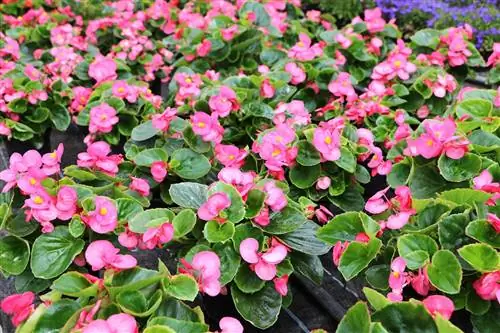
Tips for combating and preventing fungal diseases:
- separate affected areas with a clean knife
- Dispose of shoots with fungal diseases in the trash
- Protecting plants from rain
- only water near the ground
- if the infestation is severe, use a commercial fungicide
If the fungal infestation cannot be combated by removing the shoots, do not hesitate to use a fungicide on ornamental plants. There are effective biological preparations commercially available that you can use to prevent the spread.
Occasionally, ice begonias also experience root rot. The cause of this is too much water or waterlogging. If the root rot has already progressed too far, the plants can usually no longer be saved. At an early stage, quickly repotting into a dry substrate can help. Also avoid watering for the first week or two.
Pests
The ice begonias are not susceptible to pests. Only spider mites can occasionally appear in the winter quarters if the air humidity is too low. However, this problem can usually be easily solved by spraying the plants occasionally or placing a large bowl of water next to them. The ice begonia even has the advantage that it forms a barrier against a dreaded pest in the garden. Snails avoid ice begonias and are therefore also very suitable as edge plants to protect vegetables or other ornamental plants.


